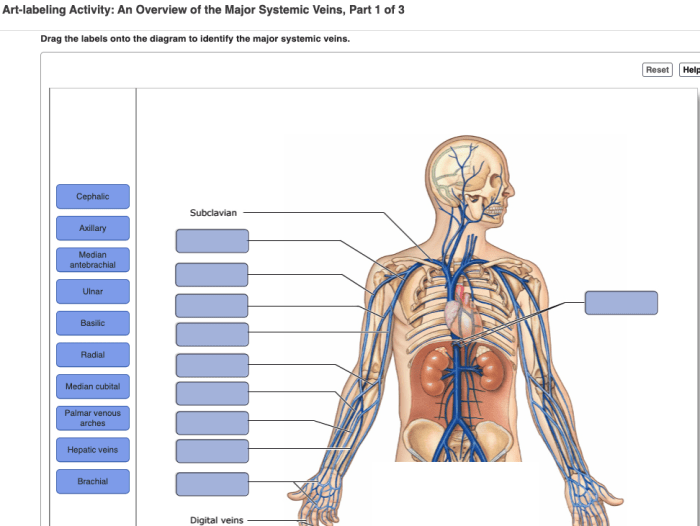Drag the labels onto the diagram to identify the arteries: a fundamental task in medical practice, requiring precision and knowledge. This comprehensive guide delves into the intricacies of arterial labeling, exploring its significance, methods, types, anatomy, and clinical applications.
Understanding the precise location and characteristics of arteries is crucial for accurate diagnosis, treatment planning, and successful surgical interventions. This guide provides a structured approach to grasping the complexities of arterial labeling, empowering healthcare professionals with the necessary knowledge and skills.
Definition and Importance of Labeling Arteries

An artery is a blood vessel that carries oxygenated blood away from the heart to the rest of the body. Arteries are essential for delivering oxygen and nutrients to the body’s tissues and organs. Accurate labeling of arteries is crucial for medical diagnosis and treatment, as it allows healthcare professionals to identify and locate arteries for various procedures and interventions.
Mislabeling arteries can have serious consequences, such as incorrect diagnosis, ineffective treatment, or even surgical complications. Therefore, it is essential to ensure accurate labeling of arteries to optimize patient care and safety.
Methods for Identifying Arteries
Various methods are employed to identify arteries, each with its advantages and limitations:
- Anatomical dissection:Involves physically dissecting and exposing arteries through surgical techniques. This method provides direct visualization but can be invasive and time-consuming.
- Angiography:A minimally invasive technique that uses X-rays and contrast dye to visualize arteries. It allows for real-time imaging but requires specialized equipment and can involve radiation exposure.
- Ultrasound:A non-invasive technique that uses sound waves to create images of arteries. It is widely used for diagnostic purposes due to its safety, portability, and cost-effectiveness.
Types of Arteries
Arteries can be classified based on their size, location, and function:
- Large arteries:Carry blood away from the heart and branch into smaller arteries throughout the body. Examples include the aorta, carotid arteries, and femoral arteries.
- Medium arteries:Branch off from large arteries and supply blood to specific organs and tissues. Examples include the renal arteries and mesenteric arteries.
- Small arteries:The smallest arteries that deliver blood directly to capillaries. They regulate blood flow to tissues and organs.
Anatomy of Arteries: Drag The Labels Onto The Diagram To Identify The Arteries

Arteries have a distinct anatomical structure consisting of three layers:
- Tunica intima:The innermost layer, lined with endothelial cells that prevent blood clotting and facilitate blood flow.
- Tunica media:The middle layer, composed of smooth muscle cells that control artery diameter and blood pressure.
- Tunica adventitia:The outermost layer, made up of connective tissue that provides structural support and protection.
Clinical Applications of Arterial Labeling
Accurate arterial labeling plays a crucial role in various medical procedures:
- Angiography:Labeling arteries during angiography allows for precise identification and visualization of blood vessels, aiding in the diagnosis and treatment of vascular diseases.
- Stent placement:Labeling arteries guides the placement of stents, which are devices used to open up narrowed or blocked arteries, improving blood flow.
- Bypass surgery:Labeling arteries enables surgeons to identify and connect blood vessels during bypass surgery, creating new pathways for blood flow to bypass obstructed arteries.
Future Directions in Arterial Labeling

Emerging technologies are revolutionizing arterial labeling:
- 3D printing:Creates physical models of arteries based on imaging data, providing surgeons with a tangible representation for preoperative planning and intraoperative guidance.
- Augmented reality:Superimposes virtual images of arteries onto the patient’s anatomy during surgery, enhancing visualization and precision.
FAQ
What is the importance of accurate arterial labeling?
Accurate arterial labeling is crucial for precise medical diagnosis, treatment planning, and successful surgical interventions.
What are the different methods used to identify arteries?
Arteries can be identified using various methods, including anatomical dissection, angiography, and ultrasound, each with its own advantages and limitations.
How are arteries classified?
Arteries are classified based on their size, location, and function, with each type playing a specific role in the circulatory system.
What are the structural components of an artery?
An artery consists of three layers: the tunica intima, tunica media, and tunica adventitia, each with distinct functions contributing to the overall function of the artery.
What are the clinical applications of arterial labeling?
Arterial labeling plays a vital role in medical procedures such as angiography, stent placement, and bypass surgery, enhancing the safety and effectiveness of these interventions.